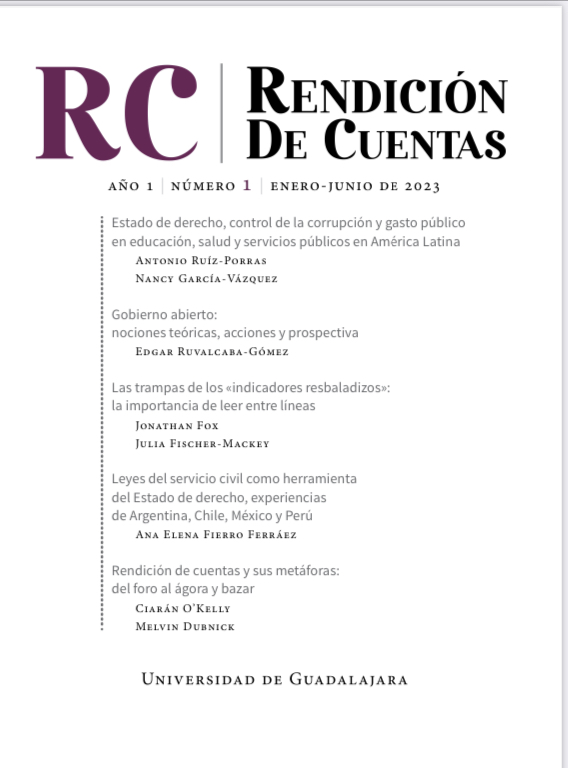Estado de derecho, control de la corrupción y gasto público en educación, salud y servicios públicos en América Latina
DOI:
https://doi.org/10.32870/rc.v1i1.22Palabras clave:
Estado de derecho, Corrupción, América Latina, Gasto públicoResumen
El propósito de este artículo es mostrar algunos hechos estilizados en las relaciones entre Estado de derecho y control de la corrupción y el gasto público en América Latina. Para efectos de comparación, los dos primeros indicadores se denominan institucionales; los indicadores de gasto público capturan los porcentajes de PIB que se destinan a educación, salud y servicios públicos. El análisis comparado se realiza para un panel de dieciseís países latinoamericanos, entre los años 2000 y 2020. Utilizamos estadísticas descriptivas, correlaciones pairwise, regresiones de mínimos cuadrados ordinarios y estimadores de bondad de ajuste...
Citas
Acemoglu, D. y Robinson, J.A. (2012). Why Nations Fail: The Origins of Power, Prosperity and Poverty. Nueva York: Crown Business.
———, Johnson, S. y Robinson, J. A. (2005). «Institutions as a Fundamental Cause of Long-Run Growth». En Aghion, P. y Durlauf, S. (Eds). Handbook of Economic Growth. Vol. I (pp. 385-472). Amsterdam: North Holland.
Baris, O. F., y Pelizzo, R. (2020). «Research Note: Governance Indicators Explain Discrepancies in Covid-19 Data». World Affairs, 183(3): 216-234.
Cárdenas, G., García, S., y Salas, A. (2018). «Institutional Framework and Governance in Latin America». International Journal of Emerging Markets, 13(5): 1088-1107. Cordis, A.S. (2014). «Corruption and the Composition of Public Spending in the United States». Public Finance Review, 42(6): 745-773.
Dam, K. W. (2006). The Law-Growth Nexus: The Rule of Law and Economic Development. Washington, DC: Brookings Institution Press.
Del Monte, A., y Pennacchio, L. (2020). «Corruption, Government Expenditure and Public Debt in OECD Countries». Comparative Economic Studies, 62(4): 739-771.
Delavallade, C. (2006). «Corruption and Distribution of Public Spending in Developing Countries». Journal of Economics and Finance, 30(2): 222-239.
Dzhumashev, R. (2014). «Corruption and Growth: The Role of Governance, Public Spending, and Economic Development». Economic Modelling, 37(1): 202-215.
Gujarati, D.N., Porter, D.C. y Pal, M. (2021). Basic Econometrics, Sexta Edición. Nueva Delhi: McGraw Hill.
Gupta, S., De Mello, L. y Sharan, R. (2000). «Corruption and Military Spending». IMF Working Paper WP/00/23». Washington, DC: Fondo Monetario Internacional.
———, H.R. Davoodi y E.R.Tiongson (2000). «Corruption and the Provision of Health Care and Education Services». IMF Working Paper, WP/00/116. Washington, DC: Fondo Monetario Internacional, 1-33.
Haber, S., Razo, M. y Maurer, N. (2003). The Politics of Property Rights: Political Instability, Credible Commitments and Economic Growth in Mexico, 1876-1929. New York: Cam- bridge University Press
Hessami, Z. (2014). Political Corruption, Public Procurement, and Budget Composition: Theory and Evidence From OECD Countries. European Journal of Political Economy, 34: 372-389.
International Monetary Fund. (2001). Manual de Estadísticas de Finanzas Públicas 2001, Segunda Edición, Washington, DC: Fondo Monetario Internacional.
Kaufmann, D., Kraay, A. y Mastruzzi, M. (2007). «Governance Matters VI: Governance Indicators for 1996-2006». World Bank Policy Research Working Paper WPS4280, Washington, DC: Banco Mundial.
———, ——— y ——— (2011). «The Worldwide Governance Indicators: Methodology and Analytical Issues». Hague Journal on the Rule of Law, 3(2): 220-246.
Kaufmann, D. (2015). «Corruption Matters: Governance has Progressed in a Few Latin American Countries but Corruption Still Hinders Development in the Region». Fi- nance & Development, 52(003), 20-23.
Keefer, P. y Knack, S. (2002). «Polarization, Politics and Property Rights: Links Between Inequality and Growth». Public Choice, 111(1): 127-154.
Knack, S., Keefer, P. (2006). «Institutions and Economic Performance: Cross-Country Tests Using Alternative Institutional Measures». En Knack, S., Democracy, Governance, and Growth (pp. 58-78). Michigan: University of Michigan Press.
——— y ——— (1995). «Institutions and Economic Performance: Cross-Country Tests Using Alternative Institutional Measures». Economics and Politics, 7(3): 207-227. Langbein, L. y Knack, S. (2010). «The Worldwide Governance Indicators: Six, one, or none?» Journal of Development Studies, 46(2): 350-370.
Makuta, I., y O’Hare, B. (2015). «Quality of Governance, Public Spending on Health and Health Status in Sub Saharan Africa: a Panel Data Regression Analysis». BMC Public Health, 15(1): 1-11.
Mauro, P. (1998). «The Effects of Corruption, Growth, Investment, and Government Expenditure». IMF Working Paper WP/96/98, Washington, DC: Fondo Monetario Internacional.
——— (1998). «Corruption and the Composition of Government Expenditure». Journal Public Economics, 69: 263-279
Nabin, M.H., Chowdhury, M.T.H. y Bhattacharya, S. (2021). «It Matters to be in Good Hands: The Relationship Between Good Governance and Pandemic Spread Inferred From Cross-Country Covid-19 Data». Humanities and Social Sciences Communica- tions, 8(1): 203, 1-15.
North, D.C. (1981). Structure and Change in Economic History. New York: Norton. ———, Wallis, J.J. y Weingast, B. (2009). Violence and Social Order: A Conceptual Framework for Interpreting Recorded Human History. New York: Cambridge University Press. Shah, A. (Ed.) (2007). Performance Accountability and Combating Corruption. Washington, DC: World Bank Publications.
Swaleheen, M., Ali, M. S. B, y Temimi, A. (2019). «Corruption and Public Spending on Education and Health». Applied Economics Letters, 26(4), 321-325.
Rajkumar, A. S., y Swaroop, V. (2008). «Public Spending and Outcomes: Does Governance Matter?». Journal of Development Economics, 86(1): 96-111.
Ruíz-Porras, A. y García Vázquez, N. (2015). «Governance and Economic Growth in Latin America: Some Stylized Facts and Relations». Journal of Public Governance and Policy: Latin American Review, 1(1): 55-76.
———, ——— y García Medina, D.P. (2015). «Gobernanza, distribución del ingreso y desempeño económico en América Latina. Nova Scientia, 7(15): 616-643.
Thomas, M. (2009). «What do the Worldwide Governance Indicators measure?» Euro- pean Journal of Development Research, 22(1), 31-54.
Wong, M.Y. (2017). «Public Spending, Corruption, and Income Inequality: A Comparative Analysis of Asia and Latin America». International Political Science Review, 38(3): 298-315.
Bases de datos
CEPAL, CEPALSTAT: Bases de Datos y Publicaciones Estadísticas. http://estadisticas.cepal.org/cepalstat/WEB_CEPALSTAT/Portada.asp (16 de septiembre de 2022). Banco Mundial. Worldwide Governance Indicators. http://info.worldbank.org/governance/wgi/index.aspx#home asp (16 de septiembre de 2022).
Publicado
Cómo citar
Número
Sección
Licencia
Derechos de autor 2023 RC RENDICION DE CUENTAS

Esta obra está bajo una licencia internacional Creative Commons Atribución-NoComercial-SinDerivadas 4.0.


